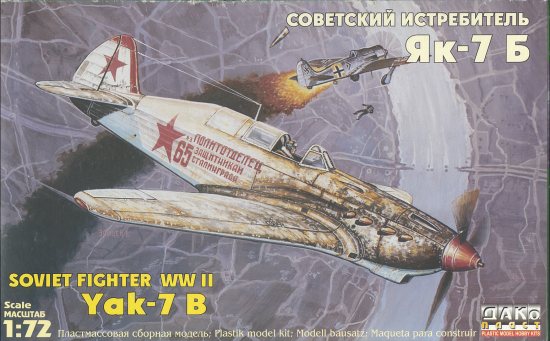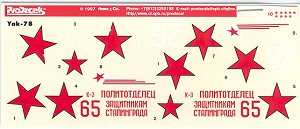
|
KIT: |
Dako 1/72 Yak-7B |
|
KIT # |
12006 |
|
PRICE: |
CDN $11.92 |
|
DECALS: |
Three aircraft |
|
REVIEWER: |
Scott Van Aken IPMS C5729 |
|
NOTES: |

|
HISTORY |
Despite this, several thousand were delivered and the type was considered the best aircraft in the force. A later modification, the Yak-7B/M-105PF had the PF engine of greater boost pressure. The fuselage was lightened, the seat was ground adjustable, and the rear canopy was replaced by ply and the rear decking somewhat revised. The rocket rails were deleted, the engine had new exhaust of six equal length ejectors per side. Other engine faults like excessive oil loss, and overheating were taken care of in the later Yak-9 series.
An even later Yak-7B(improved) was built to try to overcome the advantage
of the latest Luftwaffe fighters. This 1943 design had a number of
improvements such as a highly polished exterior with all gaps sealed and
retractable tail wheel with doors. The improvement in performance was
exceptional, however, the reality of the situation was that this high standard
would be impossible to maintain during normal production so this variant never
entered service.
|
THE KIT |

Upon first seeing the kit, I was reminded of the ICM 1/48 kit. The general detail level of the kit is quite similar. What is missing is the coating of mold release that the ICM kit was bathed in! Surface detail is very good, consisting of crisply done engraved panel lines. Surface texture of the medium grey plastic is a tad rough (as in not ice smooth), though a coat of paint will easily take care of that. Fabric representation is fair, consisting of the usual hill and valley approach, but not too overdone. I always look for flash, sink areas and ejector pin marks/towers when reviewing kits. This one has all three, though not in abundance and most of it can easily be corrected. Only a few pieces had any real flash. There were sink areas on the rudder and floor (thick plastic), and lower wing (opposite ejector towers). Ejector stubs of varying lengths are limited to the wings and fuselage. Those on the wings will have to be removed prior to construction. Clear bits are well molded, a touch thick and somewhat distorted. The canopy is separate and though I'm not sure if it can be posed open, if closed, the distortion will prevent any interior detail from easily being seen. There are no optional parts.
The instructions are quite well done. It is basically a single sheet of folded paper with the 7 step construction sequence and paint/decal placement guide on one side, with the history, warnings and paint guide on the other. Paints are in Humbrol, VVS, and FS 595 numbers where appropriate. A generic name is also provided.
 Markings are provided for three
aircraft. First is the box art plane from the Stalingrad area in 1942/43 in
white uppers with aircraft blue undersides and a patriotic slogan on the
fuselage. It has a spinner and fin tip in red. Next is a mid 1943 plane, white
26 in brown and green uppers with aircraft blue undersides from the 3 IAC. It
sports a white fin tip with a white spinner tipped in red. Finally is white 1
from 1942. It is also in brown and green uppers with a light blue underside.
This one has a patriotic banner on the fuselage. The decals are by Prodecals,
are well printed and are glossy. They also seem to be quite opaque. A set of
kill markings is stapled to the upper right of the sheet for use with the final
aircraft.
The
Markings are provided for three
aircraft. First is the box art plane from the Stalingrad area in 1942/43 in
white uppers with aircraft blue undersides and a patriotic slogan on the
fuselage. It has a spinner and fin tip in red. Next is a mid 1943 plane, white
26 in brown and green uppers with aircraft blue undersides from the 3 IAC. It
sports a white fin tip with a white spinner tipped in red. Finally is white 1
from 1942. It is also in brown and green uppers with a light blue underside.
This one has a patriotic banner on the fuselage. The decals are by Prodecals,
are well printed and are glossy. They also seem to be quite opaque. A set of
kill markings is stapled to the upper right of the sheet for use with the final
aircraft.
The
|
CONCLUSIONS |
Overall, this looks like a very nice kit. There are not a lot of parts to it and barring any fit problems, should be able to be constructed rather quickly. I don't know if any other injected Yak-7s are around, so this one will be most welcome to VVS enthusiasts.
Thanks to IPMS Canada and Sky Grid for the review kit.
If you would like your product reviewed fairly and quickly by a site that has 200,000 visitors a month, please contact me or see other details in the Note to Contributors.